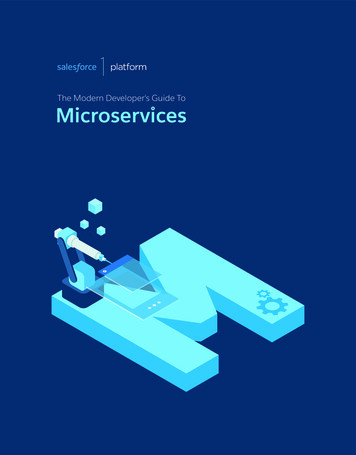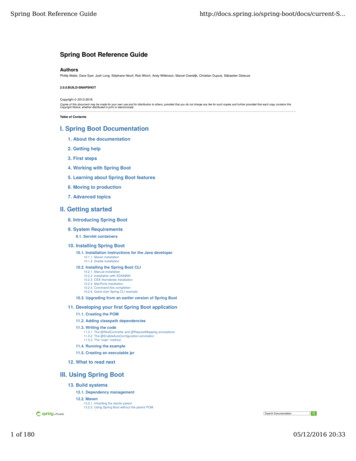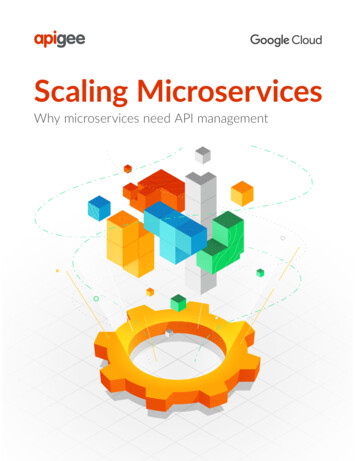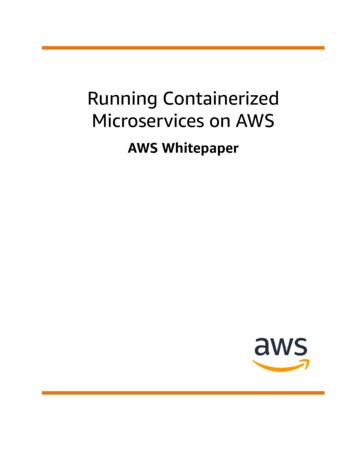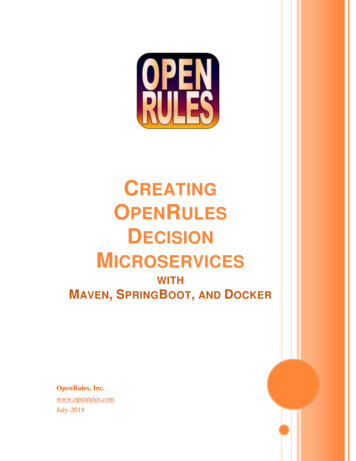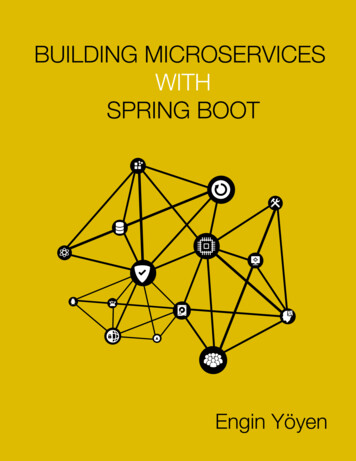
Transcription
Building Microservices with Spring BootEngin YöyenThis book is for sale at ing-bootThis version was published on 2019-08-25This is a Leanpub book. Leanpub empowers authors and publishers with the Lean Publishingprocess. Lean Publishing is the act of publishing an in-progress ebook using lightweight tools andmany iterations to get reader feedback, pivot until you have the right book and build traction onceyou do. 2016 - 2019 Engin Yöyen
ContentsPreliminaries . . . . . . .Errata & SuggestionSource Code . . . . .Credits . . . . . . . .iiii7. Communicating with HTTP Clients . . . . .7.1 Spring’s Rest Template . . . . . . . . . . .7.2 Handling Errors . . . . . . . . . . . . . . .7.3 Asynchronous HTTP Requests . . . . . .7.4 Handling Domain Model Across Services7.5 Netflix’s Zuul . . . . . . . . . . . . . . . . .7.6 HTTP Connection Pool . . . . . . . . . . . . iii. . iii. . viii. . xi. . xix. . xxii. xxviii.
PreliminariesErrata & SuggestionIf you find any mistake in the text, code or in logic or you have a suggestion regarding the content,please do not hesitate to drop an email.mail@enginyoyen.comSource CodeExamples that are giving in this book are freely available from the GitHub. Almost all of the codeexamples are in a git repository. You can access all of the source code h-spring-boot¹Examples contains a partial url such as:Listing 1.3 - A first look at a Spring Boot - 23.In this case, directory 01 will be in the following repository and the full URL would Social-media icon designed by Plainicon, from http://www.flaticon.com/authors/plainicon.Bug, Network Protection, Plugin, Database, Locked Padlock, Navigation Arrow, CPU, Electrodes,Hard Drive, Energy Atom, Registry, Chip, Hacked Computer, energy, Tools Cross Settings Symbol for Interface, Crowd of Users, Reload Arrow, Web Guard icons designed by Freepik h-spring-boot/ch01-microservices-and-spring
Preliminariesii
7. Communicating with HTTP ClientsMicroservice style architecture is often build using REST over HTTP. Which also means, that servicesneed to communicate with each other, hence information is distributed into smaller services. In theprevious chapter, strategies for connecting HTTP APIs were introduced. In this chapter, I am goingto use the basis of discussion from Chapter 6 and explain how HTTP services can communicate witheach other by using Spring and Spring Boot.7.1 Spring’s Rest TemplateRestTemplate is a class in spring web package, for synchronous client-side HTTP access. The soleaim is to simplify communication with HTTP servers. That is it actually this is all RestTemplate does.It offers methods that will handle HTTP operations very easily, such as retrieving data, posting dataor retrieving all HTTP message headers.7.1.1 Simple GET RequestLet’s begin with a very simple example. We are going to request user information from GitHub. Weare going to create a class and add the following properties as in Listing 7.1. RestTemplate will usethis class to convert incoming JSON data into a User class which is defined in Listing 7.1. There areonly three fields in the class, let’s assume these are the only fields we are interested at the moment.Listing 7.1 - st-template1234public class User {private String id;private String login;private String location;5678public String getId() {return id;}9101112public void setId(String id) {this.id id;}131415public String getLogin() {return login;
7. Communicating with HTTP Clientsiv}1617public void setLogin(String login) {this.login login;}18192021public String getLocation() {return location;}22232425public void setLocation(String location) {this.location location;}26272829}The second step is to create a simple controller, which will get the username from the URI path andpass it to the RestTemplate. In this example, I am going to use getForObject() method retrieve arepresentation of a resource by doing a GET on the specified URL. The response is then converted togiving object and returned, in this case, the response will be User model which was created in Listing7.1. Method accepts three parameters, URI template, class and URL variables. URI template variablehas to be the same name of the method parameter, which you can see both are literal username.Otherwise, you will get an error.Listing 7.2 - st-template12@RestControllerpublic class Controller {3RestTemplate restTemplate new RestTemplate();456789101112@RequestMapping(value "/github/{username}")User getUser(@PathVariable String username) {User user users/{username}", User.class,\username);return user;}1314}When the code is compiled then you can test it via browser or curl, respond should look as inListing 7.3. This is basically it, all you need to do for fetching something simple from an anotherHTTP service. This is how you can connect another HTTP service to your Spring Boot application.
7. Communicating with HTTP ClientsvAs you may have noticed it, the code is very simple, but in real life, services may not be that reliable,so you need to add more effort to error handling, multiple requests, etc., which we will tackle innext section.Listing 7.3 - Service Responsecurl -i -X GET http://localhost:8080/github/enginyoyenHTTP/1.1 200 OKContent-Type: application/json;charset UTF-8Transfer-Encoding: chunked{"id": "1239966","login": "enginyoyen","location": "Berlin, Germany"}7.1.2 Working with Response EntityIn the previous example information that is retrieved from the GitHub API is returned back tothe user. However, this is not partially correct because some of the information such as HTTPHeaders got lost. HTTP response contains also HTTP Headers, which are not transmitted to theclient. Information such as HTTP Headers may not be useful to the client, or you may simply wantto omit this information, in that case, the approach in the previous section will just do fine. However,if you need this information to be transmitted to the client, then there has to be a slide adjustment.getForObject method returned the object, another method for retrieving the object is getForEntitywhich essentially does the same thing, but HTTP response is stored as a ResponseEntity. In somecases, you may actually return ResponseEntity directly as in the Listing 7.4.Listing 7.4 - Returning ResponseEntity directly12@RestControllerpublic class Controller {34RestTemplate restTemplate new RestTemplate();567891011@RequestMapping(value "/github/{username}")ResponseEntity getUser(@PathVariable String username) {ResponseEntity entity users/{username}",User.class, username);return entity;
7. Communicating with HTTP Clientsvi}121314}This theoretically will work without any problem unless there has been a modification to the bodyof the response. GitHub’s response is converted to the User object, but this object does not containall the fields as in GitHub API. Controller responds only with partial information, that is returnedfrom GitHub API. This is still a useful scenario, the problem is the Content-Lenght of the HTTPresponse from GitHub API, will not be the same Content-Length as of the Spring Boot applicationhence content is reduced to only three fields. When the code in Listing 7.4 is executed, the responsewill be as in Listing 7.5 as you can see all the HTTP Headers are present, but there is also an errormessage from curl (transfer closed with 1104 bytes remaining to read).Listing 7.5 - Service Response with Headerscurl -i -X GET http://localhost:8080/github/enginyoyenHTTP/1.1 200 OKServer: GitHub.comDate: Mon, 23 May 2016 11:27:34 GMTStatus: 200 OKX-RateLimit-Limit: 60X-RateLimit-Remaining: 40X-RateLimit-Reset: 1464003944Cache-Control: public, max-age 60, s-maxage 60Vary: Accept-EncodingETag: "6da8a08a56a39efa07232d3f6868b5af"Last-Modified: Wed, 27 Apr 2016 19:18:48 GMTX-GitHub-Media-Type: github.v3Access-Control-Expose-Headers: ETag, Link, X-GitHub-OTP, X-RateLimit-Limit, X-RateLi\mit-Remaining, X-RateLimit-Reset, X-OAuth-Scopes, X-Accepted-OAuth-Scopes, X-Poll-In\tervalAccess-Control-Allow-Origin: *Content-Security-Policy: default-src 'none'Strict-Transport-Security: max-age 31536000; includeSubdomains; preloadX-Content-Type-Options: nosniffX-Frame-Options: denyX-XSS-Protection: 1; mode blockX-Served-By: d: 5E45595B:B210:3FEF45A:5742E926Content-Type: application/json;charset utf-8Content-Length: 1170curl: (18) transfer closed with 1104 bytes remaining to read
7. Communicating with HTTP Clientsvii{"id": "1239966","login": "enginyoyen","location": "Berlin, Germany"}To avoid this issue, simply removing Content-Length will be enough. Response header from therequest is immutable, therefore, to alternate it must be copied. The code sample in Listing 7.6, createsa new HttpHeaders object and copies all the headers except Content-Length header and use thisheader to create a new response.Listing 7.6 - rking-with-response-entity12@RestControllerpublic class Controller {3RestTemplate restTemplate new RestTemplate();45@RequestMapping(value "/github/{username}")ResponseEntity getUser(@PathVariable String username) {ResponseEntity entity users/{username}",User.class, username);67891011HttpHeaders responseHeaders new HttpHeaders();1213//Filter Content-Length header and add other to ach(header - {if (!header.getKey().equals(HttpHeaders.CONTENT LENGTH)) {header.getValue().forEach(headerValue - responseHeaders.set(header.getKey(), headerValue));}});14151617181920212223242526return new ResponseEntity(entity.getBody(),responseHeaders, HttpStatus.OK);2728}2930}
viii7. Communicating with HTTP ClientsWhen you run the code again and make a HTTP request, you should now see that instead ofContent-Length header there is a Transfer-Encoding header. This header added by the Spring, andmeans that data is will be transmitted in a series of chunks(see Chunked transfer encoding³). Thissimple example demonstrates how you can work or manipulate HTTP client response.Listing 7.7curl -i -X GET http://localhost:8080/github/enginyoyenHTTP/1.1 200 OK.Transfer-Encoding: chunked{"id": "1239966","login": "enginyoyen","location": "Berlin, Germany"}7.1.3 Other RestTemplate MethodsIn the previous section, you have seen an example of how you can retrieve the data. The rulesare exactly same for other operations. Therefore, there is no reason to go through every availablemethod. In Table 7.1, you can see the overview of the RestTemplate methods that corresponds toHTTP method verbs. Method signatures are omitted because of the length.Table 7.1 - RestTemplate ponds with information about the resourceCreates a new resourceCreates or updates the resourceDeletes the resourceGets all headers of the resourceGets allow header of the resourceExecute the HTTP method to the resourceRestTemplate MethodgetForObject, getForEntitypostForLocation, wexchange, execute7.2 Handling ErrorsConnecting HTTP services to each other brings another challenge, how do you handle errors? Inmonolith style software, it is a sequential process: handling errors are much more straight forward.³https://en.wikipedia.org/wiki/Chunked transfer encoding
7. Communicating with HTTP ClientsixWhile building microservice style architecture, you will be connecting many services to each other,there is no guarantee that services are available all the time neither response is not always successful.Therefore, it is important that each service response strictly with correct and meaningful way,meaning each service should either handle errors gracefully or make it transparent so the consumerof the service is aware of the problem. For instance, in the previous example, HTTP GET request toSpring Boot application returned response from GitHub. Let’s try the same thing with a usernamethat does not exist in GitHub as in Listing 7.4.Listing 7.8curl -i -X GET istHTTP/1.1 500 Internal Server ErrorServer: Apache-Coyote/1.1Content-Type: application/json;charset UTF-8Transfer-Encoding: chunkedDate: Sun, 15 May 2016 12:24:11 GMTConnection: close{"timestamp": 1463315051010,"status": 500,"error": "Internal Server Error","exception": eption","message": "404 Not Found","path": "/github/user-that-does-not-exist"}Response from Spring Boot application is 500 Internal Server Error, but if you try GitHub APIdirectly, you will notice that it will respond with status code 404 Not Found. This status codemakes sense because the user does not exist. RestTemplate uses DefaultResponseErrorHandler,which naturally consider anything that is client error(4xx) or server error(5xx). However, it willhelp a client to give more or better information regarding the issue. Furthermore, sending correctHTTP status code with relevant information will help you to build better consumer service, hence, aconsumer can depend on the response of the service. If the application returns only 500 HTTP statuscode for all errors, how does the consumer of that application should make any decision based on theresponse? The only reliable way for a consumer to take a correct decision based on service outputis that output should be reliable.There is a very easy solution to this problem, you can surround the RestTemplate with a try-catchblock and handle the errors if any happens. Another alternative is to use @ExceptionHandlerannotation to handle client exception. For more information about this annotation please refer tochapter 2.7 Handling Exceptions.
7. Communicating with HTTP ClientsxThe code in Listing 7.5 handles every HttpClientErrorException that occurs in the scope ofcontrollers. Error handler method has a flexible signature, so for this example, the method returnsResponseEntity and accepts HttpClientErrorException class as a parameter. The method is a verysimple one, it gets the response body, headers and status code of the HTTP request and returns itback as a response. To simply put, it pipes back the complete response(which considered error) fromthe client.Listing 7.9 - ndling-errors12@ControllerAdviceclass ExceptionHandlerAdvice {3@ExceptionHandler(value HttpClientErrorException.class)ResponseEntity ? handleHttpClientException(HttpClientErrorException exception) throws Exception{return new atusCode());}456789101112}When you compile and run the application, HTTP request(with existing username) to the applicationwill return the same result as in Listing 7.6. However, when GitHub API generates HTTP responsein the range of what is considered error such as 4xx or 5xx(for instance request with the wrongusername), application pipes back the response of the client as in Listing 7.10.Listing 7.10curl -i -X GET istHTTP/1.1 404 Not FoundServer: GitHub.comDate: Wed, 18 May 2016 19:43:07 GMTStatus: 404 Not FoundX-RateLimit-Limit: 60X-RateLimit-Remaining: 59X-RateLimit-Reset: 1463604187X-GitHub-Media-Type: github.v3Access-Control-Expose-Headers: ETag, Link, X-GitHub-OTP, X-RateLimit-Limit, X-RateLi\mit-Remaining, X-RateLimit-Reset, X-OAuth-Scopes, X-Accepted-OAuth-Scopes, X-Poll-In\tervalAccess-Control-Allow-Origin: *Content-Security-Policy: default-src 'none'Strict-Transport-Security: max-age 31536000; includeSubdomains; preload
7. Communicating with HTTP ClientsxiX-Content-Type-Options: nosniffX-Frame-Options: denyX-XSS-Protection: 1; mode blockX-GitHub-Request-Id: 5F5BF61E:B215:93E3337:573CC5CAContent-Type: application/json;charset utf-8Content-Length: 77{"message": "Not Found","documentation url": "https://developer.github.com/v3"}This approach is helpful because there might be other errors that occur, for instance, GitHub appliesrate limiting, and if you are making a unauthenticated request, you can make up to 60 requests perhour. When that number is exceeded server response with 403 Forbidden status code. With currenterror handling mechanism, this message is completely transparent, see Listing 7.11.Listing 7.11curl -i -X GET istHTTP/1.1 403 ForbiddenServer: GitHub.comStatus: 403 ForbiddenX-RateLimit-Limit: 60X-RateLimit-Remaining: 0X-RateLimit-Reset: 1463604187Content-Type: application/json;charset utf-8Content-Length: 246{"message": "API rate limit exceeded for xxx.xxx.xxx.xxx.(But here's the good news: Authenticated requests get a higherrate limit. Check out the documentation for more details.)","documentation url": .3 Asynchronous HTTP RequestsMicroservice style system can be a very chatty system. In monolithic style software, informationretrieval is simply a method call in the same process(at least in most of them). As the system gets
xii7. Communicating with HTTP Clientsdivided into smaller services, naturally services start to communicate with each other. Previousmethod calls in the same process, are now HTTP calls into different isolated services. Service Adepends on Service B and C, Service B depends on Service D and that depends on datastore, etc.Once you have all the components in place, you need to ensure the performance of the system. Asyou would remember, in previous Chapter 6.3 API Gateway, there was an example of a client makinga single request and service merging all the request from different services.Figure 7.1 - Merging Request in ServiceIf we take that example again, in a sequential program, each HTTP request has to be executed andhas to be completed either with a succesful result or a failure, for next HTTP call to be made, hencemethod cannot proceed forward. Math is very clear, if there are n number of HTTP requests, youhave to add up request-response time of each request, and local processing time of retrieved data,which will be the total time needed for an application to respond a single HTTP request.An alternative to this synchronous approach is creating asynchronous tasks that will execute inbackground parallel. So you will reduce the request-response time to longest execution time of abackground task and local processing time. Usually, most developers are happy when they do nothave to get they hands dirty with threads, but in this case, the task is relatively simple, so no needto worry about it.To demonstrate the functionality, I will use the same GitHub example in section 7.1.1 and extend it.URI will stay same, but Spring Boot application will respond with: user information (same as in section 7.1.1) of the given username
7. Communicating with HTTP Clientsxiii name of all the repositories of the given username name of all the organizations of the given usernameThere will be three separate asynchronous HTTP request for each information group and when allof them are retrieved it will be merged and delivered to the client as a response.First we need to create the data model for repositories and organizations, I will pick up only onefield, which should be enough to demonstrate the functionality.Listing 7.12 - Repositories - ynchronous-http-requests12public class Repositories {private String name;3public String getName() {return name;}4567public void setName(String name) {this.name name;}891011}Listing 7.13 - Organizations - ynchronous-http-requests12public class Organizations {private String login;3public String getLogin() {return login;}4567public void setLogin(String login) {this.login login;}891011}All three requests that are made to GitHub API are separate but the application will merge andresponse back to a single HTTP request. Therefore, I will extend the User class to add repositoriesand organizations.
7. Communicating with HTTP Clients1234Listing 7.14 - Organizations - ynchronous-http-requestspublic class User {private String id;private String login;private String location;567private List Repositories repositories;89private List Organizations organizations;10111213public String getId() {return id;}14151617public void setId(String id) {this.id id;}18192021public String getLogin() {return login;}22232425public void setLogin(String login) {this.login login;}26272829public String getLocation() {return location;}30313233public void setLocation(String location) {this.location location;}34353637public List Repositories getRepositories() {return repositories;}3839404142public void setRepositories(List Repositories repositories) {this.repositories repositories;}xiv
7. Communicating with HTTP Clientsxvpublic List Organizations getOrganizations() {return organizations;}43444546public void setOrganizations(List Organizations organizations) {this.organizations organizations;}47484950}I will create a class called GitHubClient and so I can add all the HTTP request methods in this class.This class will be annotated with @Service annotation so I can wire up in the controller.Listing 7.15 - GitHubClient - ynchronous-http-requests123@Servicepublic class GitHubClient {RestTemplate restTemplate new RestTemplate();45}Next thing we need to do, is to create the method that makes HTTP request, we just have to use thesame code as before, which will be as in Listing 7.16.Listing 7.16 - GitHubClient - ynchronous-http-requests12345public User getUser(@PathVariable String username){User user users/{username}",User.class, username);6return user;78}To make that HTTP request method asynchronously, there are two changes, we need to do for that,first, we need to mark the method with @Async annotation, so Spring will run that in a separatethread. Second we need to return the response type of CompletableFuture T instead of User.CompletableFuture represent the result of an asynchronous computation that may be explicitlycompleted. This class is part of JDK 1.8(see CompletableFuture⁴). You can see the code in Listing7.17, there has been no adjustment to HTTP request and when it is completed, it will returnCompletableFuture an already completed value. Furthermore, you can see that before values arereturned, the thread is paused for 2 seconds, this is only added to artificially produce a delay, so wecan verify the ml
7. Communicating with HTTP ClientsxviListing 7.17 - GitHubClient - ynchronous-http-requests12345678910@Asyncpublic CompletableFuture User getUser(@PathVariable String username)throws Exception{User user users/{username}",User.class, username);Thread.sleep(2000L);return g organizations and repositories are in equally same, therefore, there is no need to explainthe code. You can see the complete class in Listing 7.18.Listing 7.18 - Complete GitHubClient - ynchronous-http-requests12@Servicepublic class GitHubClient {34RestTemplate restTemplate new RestTemplate();56789101112131415@Asyncpublic CompletableFuture User getUser(@PathVariable String username)throws Exception{User user users/{username}",User.class, username);Thread.sleep(2000L);return 0212223242526@Asyncpublic CompletableFuture List Repositories getRepos(@PathVariable String username) throws Exception{Repositories[] user users/{username}/repos",Repositories[].class, username);Thread.sleep(2000L);return er));}
7. Communicating with HTTP Clientsxvii2728@Asyncpublic CompletableFuture List Organizations getOrganizations(@PathVariable String username) throws Exception{Organizations[] user users/{username}/orgs",Organizations[].class, username);Thread.sleep(2000L);return er));}2930313233343536373839}In Listing 7.19 you can see the controller that now uses the GitHubClient class to make HTTP requests. Methods getUser(String username), getRepos(String username) and getOrganizations(Stringusername) are called one after another without waiting for HTTP request to be completed.After all three HTTP requests are initiated, static allOf method is being called with all threeCompletableFutures. What this method does is it takes an array of futures and returns a CompletableFuturesthat is completed when all of the given CompletableFutures are completed. The join() methodafterward, returns the result value when a future is completed. Long story short: allOf and joinawaits completion of a set of independent CompletableFutures before continuing with the executionof the code. This is beneficial, hence, we need to return all of the information that is retrieved atonce. Next line simply references the User object for ease of readiablity, get() method on futurewaits if necessary to complete, and then returns its result, but the previous line already madesure of that. Organizations and repositories are assigned to User object and this is returned back.Stopwatch(from google’s guava library) at the beginning and at the end of the method is used togive more information about the length of the processing time.Listing 7.19 - Complete Controller - ynchronous-http-requests12@RestControllerpublic class Controller {345@AutowiredGitHubClient gitHubClient;67Logger logger equestMapping(value "/github/{username}")User getUser(@PathVariable String username) throws Exception {Stopwatch stopwatch Stopwatch.createStarted();1213CompletableFuture User maybeUser gitHubClient.getUser(username);
xviii7. Communicating with HTTP ClientsCompletableFuture List Repositories bleFuture List Organizations 4151617 18CompletableFuture.allOf(maybeUser, maybeRepos, maybeOrgs).join();1920User user 2425stopwatch.stop();logger.info("All request completed in " return user;30}3132}If you go ahead and give it a try response of the service should be above 6 seconds as each request isbeing paused 2 seconds(see Listing 7.17 and 7.18). Which I urge you to try. Only missing part is to tellSpring container asynchronous method execution capability, to do you need to add @EnableAsyncannotation. After adding this annotation you can test it again and now response you get should bea bit above 2 seconds.Listing 7.20 - Complete Controller - BootApplicationpublic class Application {public static void main(String[] args) {SpringApplication.run(Application.class, args);}}When you execute the code you should see the repositories and organizations are delivered as wellas in Listing 7.21.
7. Communicating with HTTP ClientsxixListing 7.21curl -i -X GET http://localhost:8080/github/enginyoyenHTTP/1.1 200 OKContent-Type: application/json;charset UTF-8Transfer-Encoding: chunked{"id": "1239966","login": "enginyoyen","location": "Berlin, s is a very simple example, but it shows you that with bit more work you can actually implementasynchronous tasks and for sure it will make a lot of improvements to the performance of yoursystem. If you are connecting many clients and doing multiple operations you need to take advantageof concurrency unless you have a very good reason not to do so.7.4 Handling Domain Model Across ServicesEach microservice delivers a sort of result representing the business domain. The assumption ofcourse that each service is divided well enough that they do not need to know the internals of theother services. But then again, there is always an intersection in a system where services have tocommunicate with each other, which also means they have to understand what the other serviceoffer as a domain model. This may sound a very regular issue and indeed, it is, but before we diveinto solution context, let’s examine a use case. In Figure 7.2, a small part of a call-center systemsetup is
Preliminaries Errata&Suggestion easuggestionregardingthecontent, pleasedonothesitatetodropanemail.


